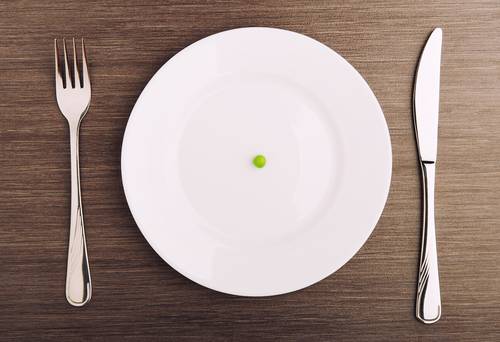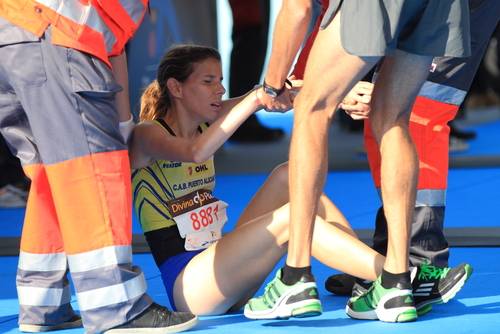Everyone knows that the way to lose weight is by using a simple formula where the calories out are greater than the calories in. What a lot of people forget is that your results in triathlons or other endurance events are based on one simple metric: your time. I have yet to find a triathlon where they weigh the athletes and use that as a factor for determining your placing.
Besides, simply reducing calories does not mean you will lose weight. The storage of fat is based on the work of insulin to manage blood sugar. In fact, two studies on super low-calorie diets – one in which participants ate only a thousand calories and the other where participants fasted – showed that people on a thousand calorie diet could actually gain weight:
So, simply restricting calories may not help with weight-loss goals. Furthermore, the issue for athletes is that they typically want to achieve three things with their training and diet:
- Improve performance
- Achieve the ideal racing weight
- Improve performance
While restricting calories may cause a reduction in weight, extreme calorie reduction has a greater impact on performance and actually creates a body composition that is often the opposite of what an athlete is trying to achieve. Over a period of time, extreme calorie reduction places the body into what is labeled “starvation mode.” The primary fuel source for the brain is ketones that are derived from body fat (which is why a ketogenic diet “works”). But if the brain believes that the volume of calories being burned far exceeds the amount being consumed, then it starts to worry and a number of things happen:
 Low glycogen stores. We can store about 1,500 calories of glycogen and this is our primary fuel source for high-intensity training. If we are not consuming enough calories to reload this, then our tank empties and we have no fuel to push our hard efforts. Ever been in a race or a hard session and you try and push harder, but your heart rate is dropping and you just cannot push? This is because the glycogen tank is empty. Glycogen takes about 24 hours to reload.3 If you run out during a race, it’s going to be a long day.
Low glycogen stores. We can store about 1,500 calories of glycogen and this is our primary fuel source for high-intensity training. If we are not consuming enough calories to reload this, then our tank empties and we have no fuel to push our hard efforts. Ever been in a race or a hard session and you try and push harder, but your heart rate is dropping and you just cannot push? This is because the glycogen tank is empty. Glycogen takes about 24 hours to reload.3 If you run out during a race, it’s going to be a long day.So the effect of a large gap between calories consumed and calories expended can be summed up in two statements:
- You don’t improve or you get slower.
- You maintain fat and lose muscle tone.
Both are the exact opposite of what most people set out to achieve. So, the question becomes, “How many calories should I consume if I want to lose weight without impacting performance?”
 First ask yourself, do you need to lose weight? I hear so many endurance athletes say they want to lose 5kg (five seems to always be the magic number for some reason). Why? Is it a super hilly course? Are you trying to reduce stress on joints? Look at the performance reason before the number. I often say that this number is derived using the REM technique – the rectal extraction method.
First ask yourself, do you need to lose weight? I hear so many endurance athletes say they want to lose 5kg (five seems to always be the magic number for some reason). Why? Is it a super hilly course? Are you trying to reduce stress on joints? Look at the performance reason before the number. I often say that this number is derived using the REM technique – the rectal extraction method.
If you do determine that you want to lean down use this method:
- Start with 1,700 (the average base metabolic rate for men, use 1,410 for women).
- If you have a hard session of one-hour in duration, add 800.
- If you have an easy session (long run/ride), add 600 per hour.
- If you are doing weights, add 600.
Take your weight in kilograms and multiply it by 4.8 (i.e. 70 x 4.8 = 336). This is the amount of protein you must have. The remaining calories (2,764) are energy – whether this is derived from good fats in a ketogenic diet or low-glycemic carbohydrates.
These numbers may be slightly incorrect when it comes to your individual factors. This can be adjusted based on how your body responds, but always try and keep within the range of around 400 calories maximum deficit.
A focus on reducing calories is extremely common with triathletes who focus on weight as a metric of progress. But a focus on fueling the training with the right nutrients and a small calorie reduction where needed can produce a far greater overall outcome.
References:
1. Kekwick, A. and Pawan, GL., “Calorie intake in relation to body-weight changes in the obese.” Lancet. 1956 Jul 28;271(6935):155-61.
2. Benoit FL., Martin RL., Watten RH., “Calorie intake in relation to body-weight changes in the obese.” Ann Intern Med. 1965;63(4):604-612.
3. Bussau VA., Fairchild TJ., Rao A., Steele P., Fournier PA., “Carbohydrate loading in human muscle: an improved 1 day protocol.” Eur J Appl Physiol. 2002 Jul;87(3):290-5. Epub 2002 May 28.
4. Ivy JL., Lee MC., Brozinick JT Jr., Reed MJ., “Muscle glycogen storage after different amounts of carbohydrate ingestion.” J Appl Physiol (1985). 1988 Nov;65(5):2018-23.
Photos courtesy of Shutterstock.






